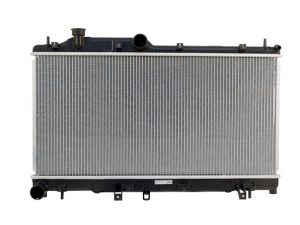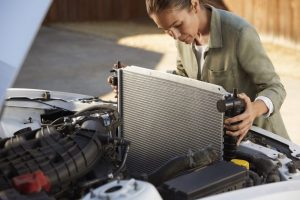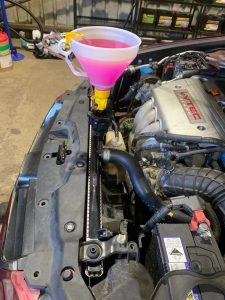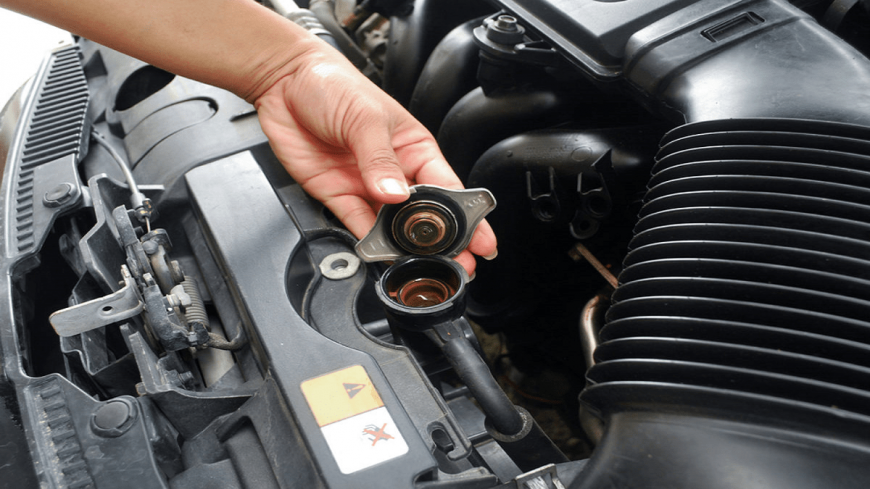What is a Radiator?
A car radiator is an essential cooling component that helps in circulating the coolant in the engine. An overheated engine may lead to several problems including severe damage to the machinery of the vehicle. Your car may break down that may lead to some major accidents. Car radiator protects your vehicle from all such instances. It must be maintained regularly to ensure that your vehicle runs smoothly in the long run.

Symptoms you may need a Radiator Replacement:
- Vehicle overheating
- Vehicle leaking fluid (Red, Green or Blue)
- Hissing sound coming from under the bonnet after driving
- Steam coming from under bonnet when driving
Maintenance tips to improve the performance of your car radiator.
- Perform timely checks on your radiator
- Use the right quality coolant
- Check the fluid
- Do not overload the car
- Check the water levels
- Use an engine coolant
- Flush the radiator

How to Replace a Radiator
Your radiator has electrical connections. Disconnect the battery before proceeding. You’ll need to raise the vehicle so you can access your radiator. You can use a car jack and stands to keep the vehicle up, but remember to put a chock behind the wheels and engage the parking brake. Wait until the engine is cold before proceeding.
This job can be dangerous, so be extra careful. You will encounter sharp edges and other circumstances that could cause injury. Protect yourself by wearing quality safety gloves and goggles. Be watchful of any moving items while working.
And, to repeat, make sure the car, engine, and coolant are NOT hot!
Materials Needed
- Air compressor (optional)
- Cooling system vacuum fill tool (optional)
- Flare nut wrench of the appropriate size
- Jack and jack stands
- Pliers
- Protective gloves
- Ratchet and sockets of the appropriate size
- Ratchet extension
- Safety glasses
- Screwdriver
- Wrenches of the appropriate size
Step 1: Raise and support the vehicle. Safely support the vehicle by jacking it up and supporting it with jack stands. Place a wheel chock behind the rear wheels and set the parking brake.
Step 2: Drain the coolant from the radiator. Open the petcock valve or remove the lower radiator hose to drain the coolant from the radiator.
Step 3: Disconnect the radiator reservoir hose. Loosen the hose clamp using either pliers or a screwdriver, depending on the clamp design. Disconnect the hose by twisting and pulling it away from the radiator.
Step 4: Remove the upper radiator hose. Loosen the hose clamps using either pliers or a screwdriver, depending on the clamp design. Then remove the hose by twisting and pulling it away from the connection.
Step 5: Remove the lower radiator hose. Loosen the hose clamps using either pliers or a screwdriver, depending on the clamp design. Then remove the hose by twisting and pulling it away from the connection.
Step 6: Disconnect the cooling fan electrical connector. Disconnect the cooling fan electrical connector by pushing on the tab and pulling it back.
Step 7: Remove the cooling fan mounting bolts. Remove the cooling fan mounting bolts using a ratchet, extension and socket of the appropriate size.
Step 8: Remove the cooling fan. Remove the cooling fan from the vehicle.
Step 9: Disconnect the transmission cooler lines. Disconnect the transmission cooler lines from the radiator using a flare nut wrench to prevent rounding off the fittings.
Step 10: Remove the radiator mounting bolts. Remove the radiator mounting bolts using a wrench or ratchet and socket of the appropriate size.
Step 11: Remove the condenser mounting bolts. Remove the condenser mounting bolts using a wrench or ratchet and socket of the appropriate size.
Step 12: Remove the radiator. Remove the radiator from the vehicle.
Step 13: Mount the radiator. Mount the new radiator in position.
Step 14: Install the condenser mounting bolts. Install the condenser mounting bolts and tighten them down.
Step 15: Install the radiator mounting bolts. Install the radiator mounting bolts using a wrench or ratchet and socket of the appropriate size.
Step 16: Connect the transmission cooler lines. Connect the transmission cooler lines to the radiator using a flare nut wrench to prevent rounding off the fittings.
Step 17: Mount the fan. Mount the cooling fan in position.
Step 18: Install the cooling fan mounting bolts. Install the cooling fan mounting bolts using a ratchet, extension and socket of the appropriate size.
Step 19: Reinstall the connector. Reconnect the cooling fan electrical connector.
Step 20: Install the lower radiator hose. Slide the hose onto the connection. Using either pliers or a screwdriver (depending on the clamp design), slide the hose clamps into position and tighten them down.
Step 21: Install the upper radiator hose. Slide the hose onto the connection. Then, using either pliers or a screwdriver (depending on the clamp design), slide the hose clamps into position and tighten them down.
Step 22: Connect the radiator reservoir hose. Slide the hose onto the connection. Then, using either pliers or a screwdriver (depending on the clamp design), slide the hose clamp into position and tighten it down.
Step 23: Fill the radiator with coolant. Close the drain petcock as needed. Then fill the radiator with coolant.

Step 24: Bleed the air from the cooling system. Air can be bled from the cooling system either by opening the bleeder valve if equipped, or using a cooling system vacuum fill tool attached to shop air. On some vehicles, it is possible to bleed the cooling system of air by running the engine with the radiator cap off and allowing coolant to puke out.
Step 25: Lower the vehicle. Jack up the vehicle and remove the jack stands. Then lower the vehicle and remove the wheel chock.
Tips to Remember:
- It is a good idea to pressure test the cooling system after a repair is carried out, to ensure no other cooling components are leaking.
- Replacing the thermostat is also a good idea when replacing the radiator, to make sure it is in good working condition
- Replacing the coolant at recommended intervals will increase the life of your radiator. Many manufacturers recommend to replace the coolant every 5 years, depending on kilometers travelled.
Why replacing the Radiator is important?
The radiator is the main cooling system component in your vehicle, and failing to replace a faulty or leaking radiator can lead to expensive engine damage if overheating occurs.
It can also leave you stranded in an unsafe location waiting for roadside assistance.
Radiator replacement is a big job. If this seems like a task you’d prefer to leave to a professional, Sydney Car Repair offers expert radiator replacement, bring your car to our workshop in Ermington, Sydney, NSW 2115. Our experienced mechanic will help you to complete the job. Radiator Coolant, Coolant System. Call us now at 0404096583.
All of our car servicing and car repair jobs are carried out by licenced vehicle technicians with years of extensive experience across all popular and luxury makes and models.
Our Address: 71 Atkins Road, Ermington, NSW 2115

Turn on Your Camera and Scan Me to add our contact detail to your phone.
Powered by freeqr.us
If you are live in Sydney or Australia, you are welcome to visit our shop to get your car service or repair. We do car servicing and car repair job for people who live in Eastwood, Carlingford, Epping, Ryde, Ermington, Rydalmere, Parramatta, Newington, North Parramatta, Epping, North Rocks, North Mead, West Ryde, Dundas, Telopea, Oatlands, Camellia, Rosehill, Carlingford, North Eppin, Gordon, Hunters Hill, Auburn, Merrylands, Fairfield, Burwood, Ashfield, Seven Hills and all the rest of Sydney, Australia.
We can repair most of the following cars for you in sydney: TOYOTA, HONDA, BMW, BENZ, MINI, NISSAN, Mitsubishi, Subaru, Audi, Volkswagen, Hyundai, Ford, Holden, JEEP and many more。
If you are looking for Sydney car servicing, car service near me, car repair near me, tire repair near me, car mechanic near me, car scratch repair, car air conditioning repair near me,tire replacement, car windows replacement, brake repair near me, car engine repair or engine replacement please visit us, we are happy to help you to do your car serving and repair.


